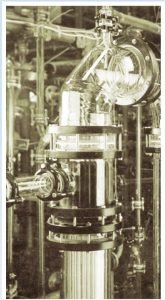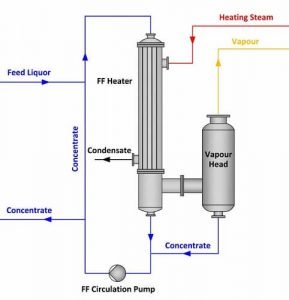Falling Film Evaporator
In the falling film evaporators, the liquid and vapors flow in the downward direction parallelly. The concentrated liquid is then preheated until it starts boiling. An evenly thin film then enters the heating area with the help of a distribution apparatus in the evaporator. It starts flowing in the downward direction at boiling temperature and gets partially evaporated.
The liquid that needs to be evaporated is then uniformly distributed on the inside of the glass tube. The liquid will start to flow down, building a thin film on the inner surface, from where the evaporation process will commence with the help of the heat generated by the steam. The steam will start condensing and will flow down on the outer surface of the glass tube. Some of the tubes are constructed together beside each other.
Both the ends of the tubes are fixed to tube plates, and finally, the tube bundle is enclosed by a shell made either of steel or Glass depending upon the steam pressure. The steam is then introduced via shell. The heating section is then formed in the space between the tubes. The inner wall of the glass tubes is known as the boiling section. The vapor and the concentrated liquid collected at the bottom of the evaporator enter the consecutive separator in a tangent position where the concentrated liquid is released via a pump at the bottom. The vapor then leaves the system from the top.
Advantages of Falling Film Evaporators
Falling film evaporators can also work, keeping a very slight temperature difference between the boiling liquid and the heating media. They also possess a short time for product contact that lasts only a few seconds per pass. Such characteristics help the falling film evaporator become suitable, especially for all the heat-sensitive products, and nowadays, it is acclaimed as the most commonly used evaporator type.
Nonetheless, the design of falling film evaporators is done carefully that is suitable for various operating conditions, respectively. If sufficient water is not sprinkled on the heating surface, it will result in having incrustations and plenty of dry patches; and in the worst-case scenario, the heating tubes will get entirely clogged.
Falling film evaporators are greatly responsive to all sorts of adjustments of the parameters, including the energy supply, feeding rate, vacuum, concentrations, etc. When you design an automatic control system with the evaporator, they are capable of producing a consistently concentrated product.
Designing
An ideal design of the liquid distribution system can be crucial to achieving to the fullest, and it can be hard for the product to wet the tubes.
Because of its low liquid holding capacity, the falling film evaporator starts its working quickly and easily changes its working mode.
Operating Principle
In falling film evaporators, the vapor and the liquid flow in the downward direction in a parallel manner. To get the highly concentrated liquid as the product, it must be preheated to the boiling temperature.
The evaporated liquid is then uniformly distributed in the glass tube on its inner surface. The liquid tends to flow in the downward direction forming a delicate film, where the process of evaporation takes place due to the heat generated by the hot oil. This hot oil is then brought in through the shell.
Size and Available Models
Falling Film Evaporator are available in the Heat Transfer Area of 2 Sq. Mt to 20 Sq. Mt. and from 4″ to 12″ in diameter and larger sizes available on request.
Final Thoughts
We are Ablaze Export Pvt. Ltd., the leading Falling Film evaporator manufacturer in Vadodara, Gujarat. Falling film evaporators are manufactured based on the shell and tube heat exchangers that help in the evaporation process of any temperature-sensitive item. Those items tend to form a useless residue by polymerization or condensation.
Looking for Best Manufacturer of Glass Pilot Plants & Turnkey Projects?



